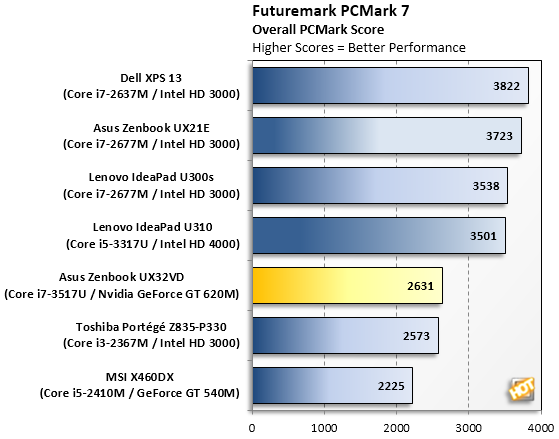We kicked off benchmarking with SiSoftware SANDRA 2012, PCMark 7, and Cinebench, which provide a look at how the system’s individual components perform as well as how the ultrabook as a whole handles everyday work and multimedia tasks. We compared the Asus Zenbook Prime UX32VD’s scores to similar systems that we have recently tested, keeping in mind that each system is likely to have different software and low level hardware configurations from the next. We test each system we review in the condition it arrives in from the manufacturer, though we disable security software and sleep settings so they won’t affect the benchmarks.
 |
| SiSoft SANDRA |
| Synthetic Benchmarks: CPU & RAM |
|
SiSoftware SANDRA 2012 lets us take a look at the way particular components perform. We ran benchmarks that test the system’s processing power, memory, and storage performance. SANDRA 2012 is the latest version of benchmark and is compatible with Windows 8, though we’re running Windows 7 on the UX32VD. Each SANDRA benchmark compares the system being tested (the red bar in each graph) to comparable systems.


SANDRA Processor Arithmetic and Multimedia Performance

SANDRA Memory Bandwidth Performance
Thanks in large part to the Core i7-3517U processor, the UX32VD scored well in SANDRA. It landed the highest Whetstone score of its competitors in the Arithmetic test and its memory bandwidth tests were strong, if not groundbreaking. Even so, it topped the 15.78GB/s score of the recently-tested Dell Latitude E6530, which runs a 2.9GHz Intel Core i7-3520M CPU in our tests.
 |
| PCMark 7 |
| General Application and Multimedia Performance |
|
Futuremark’s PCMark 7 is a well-known benchmark tool that runs the system through ordinary tasks, including word processing and multimedia playback and editing. Graphics and processor power figure prominently in this benchmark, but graphics power doesn’t play as big a role here as it does in another Futuremark benchmark, 3DMark (which is designed for testing the system’s gaming capabilities).

The UX32VD's PCMark 7 score wasn't as high as one might expect, and we suspect that its storage setup comes into play here. There’s no doubt that people with heavy storage needs will appreciate the hard drive/ SSD combo, but if you’re looking for performance, the other straight-up SSD configs in our test group, would be the way to go.
 |
| Cinebench R11.5 64-bit |
| 3D Rendering Performance on the CPU |
|
Next, we ran Cinema 4D’s content creation benchmark, Cinebench. Being graphics-oriented, this is an entertaining benchmark to watch. For the CPU test, it generates a complex image. The GPU test includes a chase scene involving two cars. The CPU test is measured in points, while the GPU test results are the chase scene’s frames-per-second.

The UX32VD handled both the CPU and GPU tests with ease, but we really saw the discrete graphics come into play in the OpenGL (GPU) test, posting a frame rate of 26.95fps. Nvidia claims the GeForce GT 620M can improve graphics performance of a notebook by 3x (assuming that ultrabook has built-in Intel HD 4000 graphics). Comparing this system to some that we have recently reviewed (and keeping in mind that it’s not an apples-to-apples comparison), we can see that the GeForce GT 620M offers an enormous boost.










